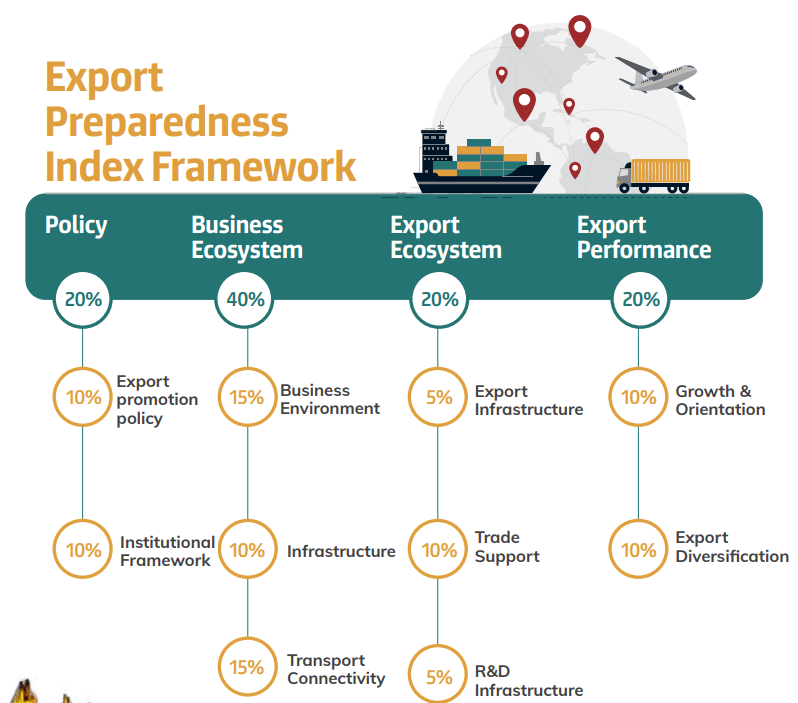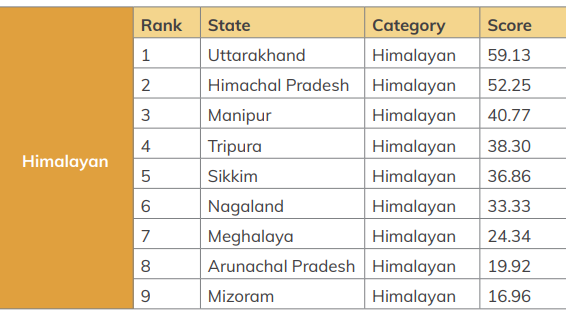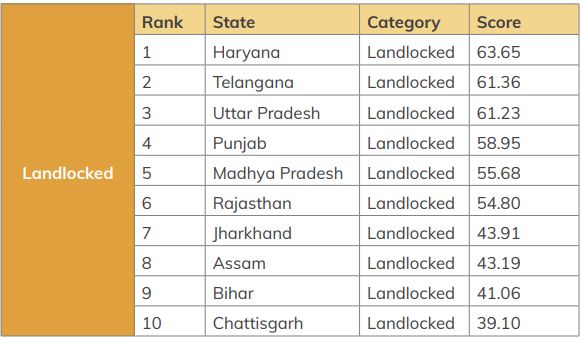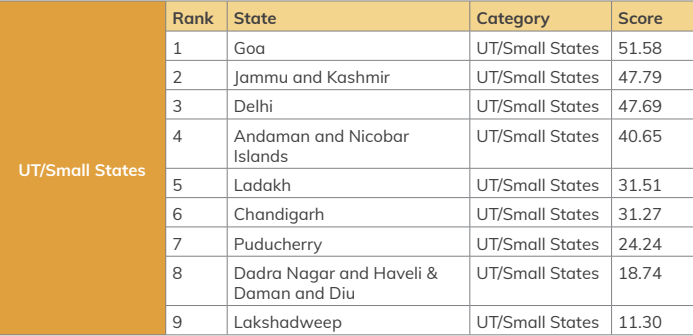Indian Economy
Export Preparedness Index 2022
- 14 Aug 2023
- 12 min read
For Prelims: Niti Aayog, Foreign Direct Investment, Technology Upgradation Fund Scheme, Geographical Indication
For Mains: NITI Aayog Report on Export Preparedness Index 2022
Recently, NITI Aayog has released a report titled- Export Preparedness Index 2022.
What is the Export Preparedness Index(EPI) 2022 ?
The EPI 2022 is a ranking of all states and union territories in India based on their export readiness. It is a composite index that measures the performance of states and UTs across 4 pillars and 10 sub-pillars:
- Pillars:
- Policy:
- A comprehensive trade policy providing a strategic direction for exports and imports.
- Business Ecosystem:
- An efficient business ecosystem helping states attract investments and create an enabling infrastructure for individuals to initiate start-ups.
- Export Ecosystem:
- Assess the business environment, which is specific to exports.
- Export Performance:
- This is the only output-based parameter and examines the reach of export footprints of States and UTs.
- Policy:
- Sub-Pillars:
- Export Promotion Policy:
- The quality and effectiveness of the state's export promotion policy.
- Institutional Framework:
- The strength and effectiveness of the state's institutional framework for trade and exports.
- Business Environment:
- The ease of doing business in the state and the availability of support services for exporters.
- Infrastructure:
- The availability of physical infrastructure, such as roads, ports, and airports, that is necessary for exports.
- Transport Connectivity:
- The connectivity of the state to major export markets.
- Export Infrastructure:
- The availability of specialized infrastructure, such as warehouses and cold storage facilities, that is necessary for exports.
- Trade Support:
- The availability of trade finance, insurance, and other trade-related services.
- R&D Infrastructure:
- The availability of research and development facilities that can help to develop new export products and services.
- Export Diversification:
- The extent to which the state's exports are diversified across sectors and markets.
- Growth Orientation:
- The state's commitment to export-led growth.
- Export Promotion Policy:
What are the Key Highlights of the EPI 2022?
- Performance of States:
- Top Performers:
- Tamil Nadu has topped in EPI 2022, followed by Maharashtra and Karnataka.
- Gujarat, which held the top position in EPI 2021 (released in 2022) has been pushed to the fourth slot in EPI 2022.
- Tamil Nadu's performance in terms of export performance indicators, including the value of exports, export concentration, and global market footprint, contributed to its top ranking.
- It has been a consistent leader in sectors such as automotive, leather, textiles, and electronic goods.
- Tamil Nadu has topped in EPI 2022, followed by Maharashtra and Karnataka.
- Hilly/Himalayan States:
- Landlocked Regions:
- Union Territories/Small States:
- Top Performers:
- Global Economy:
- Global trade in 2021 showed signs of recovery from the Covid-19. Factors like increased demand for goods, fiscal policies, vaccine distribution, and easing of restrictions contributed to a 27% increase in merchandise trade and a 16% increase in services trade compared to the previous year.
- The Russo-Ukrainian war in February 2022 slowed down the recovery, impacting sectors like grain, oil, and natural gas.
- Trade in goods saw significant growth, and services trade recovered to pre-pandemic levels by Q4 2021.
- India’s Export Trends:
- Despite global slowdown, India’s exports in 2021-22 crossed an unprecedented USD 675 Billion, with trade in goods accounting for USD 420 billion.
- The value of merchandise exports crossed USD 400 billion in FY2022, an ambitious goal set by the government, reaching up to USD 422 billion by March 2022.
- The cause of this performance was manifold. Globally, the increase in prices of commodities and rise in demand from developed countries helped increase India’s merchandise exports.
- Coastal States' Performance:
- Coastal states have shown better performance across various indicators, with six of the top states in the export index coming from the coastal region.
- These states, including Tamil Nadu, Maharashtra, Karnataka, and Gujarat, have demonstrated exceptional performance in different areas, contributing positively to the national exports due to their geographical advantage.
- Landlocked States:
- Landlocked states have generally exhibited satisfactory performance, with Uttar Pradesh and Haryana standing out as positive outliers.
- States like Punjab and Telangana have performed adequately but might not fully utilize their regional advantages, leading to average overall performance.
- Himalayan and UT/Small States:
- Himalayan and Union Territory/Small states, except for Uttarakhand, Himachal Pradesh, Goa, and Delhi, have shown unsatisfactory performance in the export index.
- This suggests a need for urgent reforms by their respective state governments to improve their export readiness.
- Policy Ecosystem and Infrastructure:
- Many states have adopted export-oriented policy measures and have implemented necessary actions to drive exports.
- The presence of dedicated industrial zones, single-window clearance, and export infrastructure has contributed to a positive business environment.
- Export growth is evident in the fact that 29 states have registered a positive growth rate in exports over their pre-pandemic levels.
- Transport Connectivity:
- The lack of air connectivity has been identified as a hindrance to the movement of goods, particularly in landlocked or geographically disadvantaged states.
- Strengthening transportation infrastructure is crucial for efficient trade.
- Cluster Strength and Innovation:
- The importance of creating a nurturing environment for industrial clusters has been highlighted, as a lack of such an environment can hinder productivity.
- The lower focus on Research and Development (R&D) and innovation in exports has been noted as a weakness.
- Manufacturing Sector and FDI Impact:
- The continuing impact of the pandemic is visible in reduced gross value addition by the manufacturing sector and decreased inflow of Foreign Direct Investment (FDI) in several states.
- The need for government support to struggling industries is emphasized.
- Capacity Building and Knowledge Dissemination:
- Proper knowledge dissemination channels are vital for exporters to compete globally.
- The absence of capacity-building workshops and limited utilization of government schemes hinder exporters' abilities to penetrate global markets.
- Export Concentration and Market Penetration:
- The high concentration of exports on a few commodities and districts, along with a significant portion of exports going to a limited number of destinations, highlights the need for diversification and exploration of new markets.
What are the Key Areas for Improvement?
- Export Diversification:
- India's export basket is still heavily concentrated in a few sectors, such as gems and jewellery, textiles, and engineering goods.
- Investment can be attracted from the countries to improve productivity, and state governments can facilitate exporters' access to information about these markets.
- Strengthening the Business Ecosystem:
- There is a need to improve the business environment in many states, including by reducing regulatory compliance costs and improving access to finance.
- Investing in R&D:
- India needs to invest more in research and development to develop new products and services that can be exported.
- Government schemes like Technology Upgradation Fund Scheme (TIES) can be utilized to create export promotion zones, research facilities, and transport infrastructure, thus enabling weaker economies to compete with strong exporting states.
- Focusing on Niche Products:
- India should focus on developing and exporting niche products that have a high value-added and are less sensitive to global economic fluctuations.
What are the Recommendations for Improvement?
- Addressing Regional Disparities:
- Different states have varying levels of preparedness and capacity for export growth.
- While policy adoption is crucial, the ability to effectively implement these policies can differ significantly from state to state.
- To bridge the gap between high-performing and lagging states, the central government should provide support to those struggling the most.
- This assistance could come in the form of funding, resources, and expertise to help build the necessary ecosystem for exports.
- States should also be encouraged to learn from each other's successes and adopt best practices.
- For example, states like Himachal Pradesh and Uttarakhand could take inspiration from other successful Himalayan states.
- Different states have varying levels of preparedness and capacity for export growth.
- Utilizing Geographical Indication (GI) Products:
- Geographical Indication (GI) products are unique to specific regions within India. States can leverage these products to establish a strong market presence.
- For instance, products like Kancheepuram Silk are exclusive to Tamil Nadu and can be exported without domestic competition.
- By improving their manufacturing, quality, and identifying global markets, states can enhance their exports.
- Geographical Indication (GI) products are unique to specific regions within India. States can leverage these products to establish a strong market presence.
- Leveraging Foreign Trade Agreements (FTAs):
- India has signed FTAs with various countries, creating more favorable trading conditions.
- States can benefit from these agreements by aligning their products with the needs of partner countries and facilitating market access.
- Exporters can seek investments from partner countries to enhance their productivity and competitiveness.
- India has signed FTAs with various countries, creating more favorable trading conditions.
- Improving Data Collection for Accurate Evaluation:
- Accurate and comprehensive data is crucial for evaluating the preparedness of Indian states for exports.
- Issues with data collection, especially for the origin of exports, need to be addressed.
- Clear data aids targeted policy formulation and understanding regional trade patterns.
- Additionally, obtaining accurate data on service exports and investment at the state level is essential to assess their contributions accurately.
- Accurate and comprehensive data is crucial for evaluating the preparedness of Indian states for exports.













